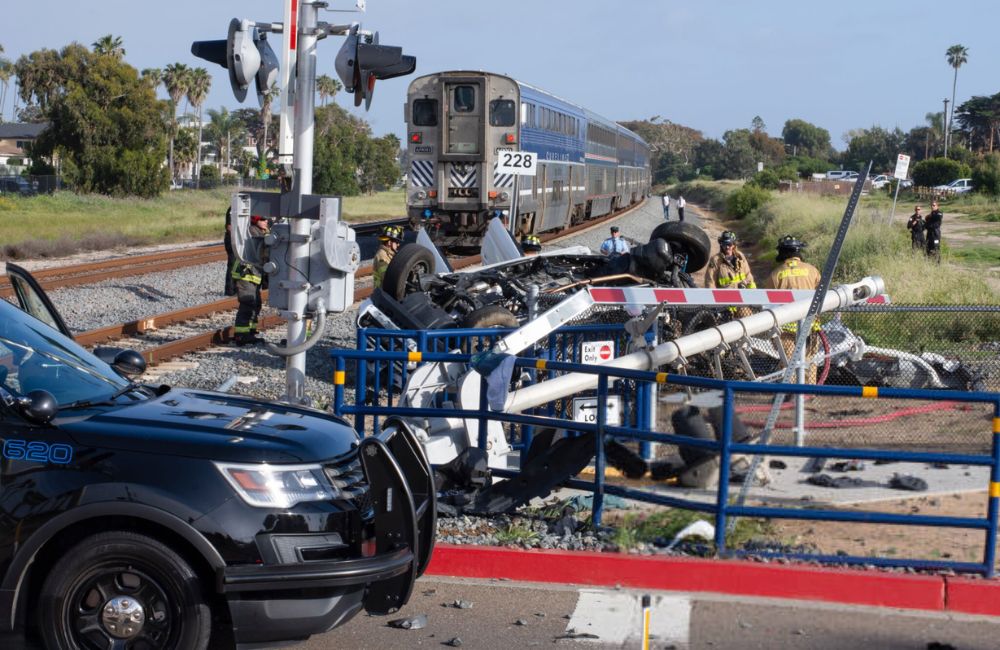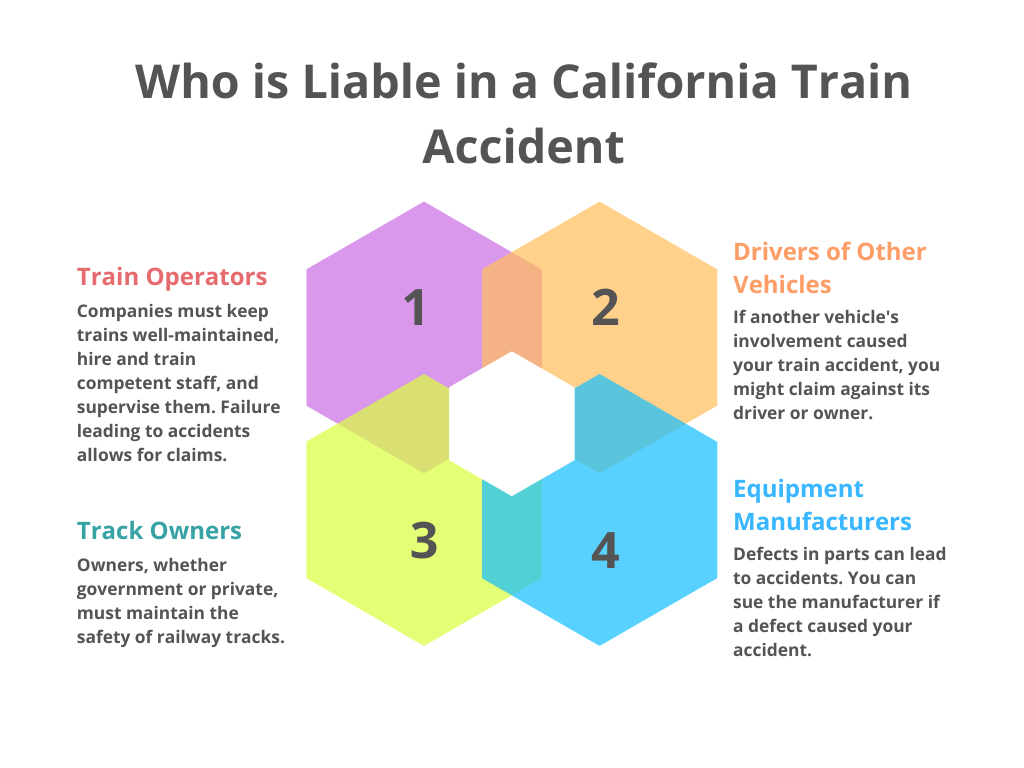Trains stand out as a safe way to travel, yet they are not entirely without danger. Serious injuries can occur to passengers, pedestrians, and drivers if those responsible for railway safety don’t take the necessary precautions. California experiences more train accidents than it should, largely due to its extensive railway system, which is one of the largest in the United States.
The Federal Railroad Administration reported over 2,000 train collisions nationwide in 2022 alone. In such situations, hiring a legal professional becomes crucial. A lawyer can help investigate the accident to see if it resulted from negligence on the part of the railway operator, conductor, or others involved.


In this article, we’ll dive into the reasons behind train accidents in California, explore the laws governing these incidents, and offer guidance on how to handle such cases.
- Most Common Types Of California Train Accident Cases
- Railroad Safety Laws In California
- How To Prove Liability In a California Train Accident
- Understanding Compensation For California Train Accidents
- Steps to Take After a Train Accident in California
- The Role Of Legal Assistance In California Train Accident Cases
Most Common Types Of California Train Accident Cases


Train accidents in California can vary widely, but knowing a few common types is essential. Each of these scenarios showcases different aspects of how negligence and liability are determined in train accidents, emphasizing the importance of safety measures and responsible conduct by all involved parties. Here’s a look at these scenarios:
Train Derailment
Derailments are among the most catastrophic train accidents, with causes ranging from conductors speeding beyond safe limits, and inadequate maintenance of rail systems, to poorly kept train cars and defective products. These incidents often point back to someone’s negligence, whether it’s the conductor’s reckless speed or the maintenance team’s oversight.
Train-to-Train Collisions
When two trains collide, the risk of serious or even fatal injuries escalates. Such collisions, like the notable 2008 Metrolink crash in Chatsworth, California, frequently result from distracted train conductors. The focus here is on the negligence of conductors whose lack of attention can lead to devastating outcomes.
Rail Crossing Crashes
At rail crossings, the high speed of an oncoming train leaves little chance for motorists and pedestrians. These accidents can occur due to drivers ignoring traffic laws and causing collisions that push vehicles onto the tracks, or because of rail system operators who neglect to repair malfunctioning signals or barriers. The negligence could lie with a careless driver or a rail system operator who didn’t maintain the crossing’s safety mechanisms.
Train Passenger Injuries
Not all train-related injuries happen during dramatic accidents. Passengers might get hurt from something as simple as a slip and fall, falling objects, or even assaults due to inadequate security measures. These cases often involve negligence within the train’s operation, from ensuring passenger safety to maintaining a secure environment.
Railroad Safety Laws In California
The California Vehicle Code includes several important rules for vehicles and pedestrians around railway areas. These laws play a critical role in minimizing the risk of train accidents in California and ensuring that both vehicles and pedestrians navigate railway crossings safely.
Key regulations are as follows:
- Prohibition on Parking Near Tracks (California Vehicle Code §22521): Vehicles are not allowed to park or stop on railroad tracks, or within 7 and a half feet from the nearest rail.
- Crossing Regulations (California Vehicle Code §22526): Vehicles must only cross railroad tracks if there is enough space on the other side to allow for the safe passage of a train, trolley, or transit rail car.
- Trespassing Laws (California Penal Code 369g): It’s considered an offense to trespass on or near railroad tracks, or to drive a vehicle on them without explicit permission from railroad officials.
- Stop Lines (California Vehicle Code 22450): Vehicles are required to stop at the white limit line before crossing railroad tracks.
- Speed Limits (California Vehicle Code 22352): The speed limit is set at 15 miles per hour within 100 feet of approaching a railroad crossing.
- Warning Signs (California Vehicle Code 21362): Warning signs must be placed on the right-hand side of the road at a reasonable distance from a railroad crossing.
- Stopping Requirements for Certain Vehicles (California Vehicle Code §22452): This rule requires school buses and commercial vehicles carrying hazardous materials to stop completely between 15 to 50 feet before crossing railway tracks. Additionally, it’s a crime under CVC §15312.1 for an employer to make a commercial driver disobey these railroad crossing laws.
Every train accident is filled with its own set of challenges and details. Should you find yourself in such a situation, The Personal Injury Center is here to support you. We’re equipped to link you with seasoned legal professionals who will delve deep into the specifics of your case and help you receive the compensation that you deserve.
How To Prove Liability In a California Train Accident


Establishing liability is crucial in personal injury or wrongful death lawsuits. To win your case, you must prove that the responsible party had a duty to keep you safe, failed in this duty, and this failure led to your injury or loss.
This duty can be violated either intentionally or through negligence, with the latter being more common in train accident cases. Typically, the responsible party did not mean to cause harm.
Who you can hold accountable depends on what specifically led to the accident.
In a train accident in California, the following parties may be held responsible:
- Train Operators: Companies running the trains must maintain their equipment and vehicles, hire competent staff, provide thorough training, and supervise their teams effectively. Failing in any of these areas, leading to an accident, means those affected can pursue a claim against them.
- Track Owners: Whether a government entity or a private company, the owner of the railway tracks must ensure they are kept safe.
- Drivers of Other Vehicles: If your train accident involved another vehicle on the tracks, you might have a case against that vehicle’s driver or owner.
- Equipment Manufacturers: Defective parts often play a significant role in train accidents. If a manufacturing defect in a part caused your accident, you might be able to file a lawsuit against the manufacturer.
Understanding Compensation For California Train Accidents


If you’ve been involved in a train accident in California, it’s important to know you might be entitled to compensation. This compensation can fall into three main categories, each addressing different aspects of your losses and suffering:
Economic Damages
- What they cover: These damages compensate for quantifiable financial losses. This includes medical expenses (like hospital bills, rehabilitation, and medication), lost wages from missing work, and property damage.
- Why they matter: Economic damages aim to restore your financial stability by covering the costs directly resulting from the accident.
Non-Economic Damages
- What they cover: These are for the intangible losses you’ve suffered. This category includes compensation for pain and suffering, emotional distress, and the loss of enjoyment in life.
- Why they matter: Non-economic damages recognize the significant, though less tangible, impacts of your accident, providing relief for your mental and emotional recovery.
Punitive Damages
- What they cover: Awarded in cases of particularly harmful behavior, punitive damages are designed to punish the wrongdoer and prevent similar conduct in the future.
- Why they matter: Although less common, punitive damages are crucial for holding the defendant accountable for their wrongful actions and preventing similar harm to others.
Each train accident case is unique, with its own complexities. If you are ever navigating such incidents, The Personal Injury Center has your back. We can connect you with legal experts who can thoroughly assess your case and help you understand the legal landscape.
Steps to Take After a Train Accident in California
Experiencing a train accident can be incredibly traumatic, leaving you in shock and unsure about how to proceed. If you’re injured in a California train accident, here’s a straightforward guide to navigating the aftermath of a train accident and securing your rights:
- Limit Your Conversations: After an accident, it’s natural to want to talk about what happened. However, it’s important to speak cautiously. Avoid giving detailed statements to the other involved parties, investigators, or insurance agents. Your words could potentially be used to limit your compensation. Before saying too much, consult with a lawyer.
- Seek Medical Attention Right Away: First and foremost, prioritize your health. Injuries from train accidents can be severe, and symptoms might not appear immediately. It’s crucial to get checked by a medical professional as soon as possible to diagnose any injuries accurately.
- Gather Evidence: While at the scene, try to document everything you can. Write down your recollection of the event, including the location, weather conditions, and any use of brakes before the crash. Note down the names and contact information of witnesses. These details can be invaluable later on.
- Notify Your Insurance Company: If your vehicle was involved in the accident, you must report it to your insurance company. However, remember that while insurance is there to help, the company also looks out for its own interests. It’s wise to have a personal injury lawyer who prioritizes your needs over the insurance company’s.
- Photograph the Scene: Photos can dramatically strengthen your case. Use your phone or camera to capture images of the accident scene and any visible injuries you’ve sustained. These images serve as powerful evidence of the incident and its impact on you.
- Consult with a Lawyer: An experienced lawyer can bring a deep understanding of California law, along with the skills and resources necessary to protect your rights and ensure you receive the fullest compensation possible for your losses.
The Role Of Legal Assistance In California Train Accident Cases
Navigating the aftermath of a train accident in California can be overwhelming. While you’re not legally required to have a lawyer to file a claim for injuries sustained, having an experienced legal team can offer substantial advantages.
Here’s why seeking legal help is crucial:
- Specialized Knowledge: Train accident cases differ significantly from car crashes or slip-and-fall incidents, falling into a unique category within personal injury law. An attorney with experience in train accident cases brings specialized knowledge crucial for navigating these complex claims.
- Rare Expertise: Given the rarity of train accidents, few lawyers have direct experience with these cases. A personal injury lawyer with a background in train accident litigation will know how to work through the insurance claims process and courtroom proceedings effectively.
- Building a Persuasive Case: An experienced lawyer knows how to document your claim and construct a compelling argument. Given that train accidents are less common, presenting the case in a way that is understandable and relatable to jurors—who may have little to no knowledge about train accidents—is essential.
- Access to Resources: The right legal expert will have access to an extensive network of resources, including investigators, subject matter experts, accident reconstruction specialists, and more. These professionals can provide invaluable insights and testimony to support your case.
- Advocacy and Support: With the complicated legal landscape of train accidents in California, having a lawyer ensures that someone is advocating for your best interests, particularly against insurance companies that prioritize their profits over your well-being.
- Maximizing Compensation: A lawyer’s expertise in train accidents can significantly impact the compensation you receive, ensuring you get the maximum amount for your injuries, losses, and suffering.
Although it’s possible to handle a train accident claim independently, the complexities of such cases make it important to have professional legal support. The Personal Injury Center is ready to connect you with skilled legal professionals in your region. These experts excel in gathering compelling evidence and crafting a strong argument for your personal injury claim.
Key Takeaways
|



